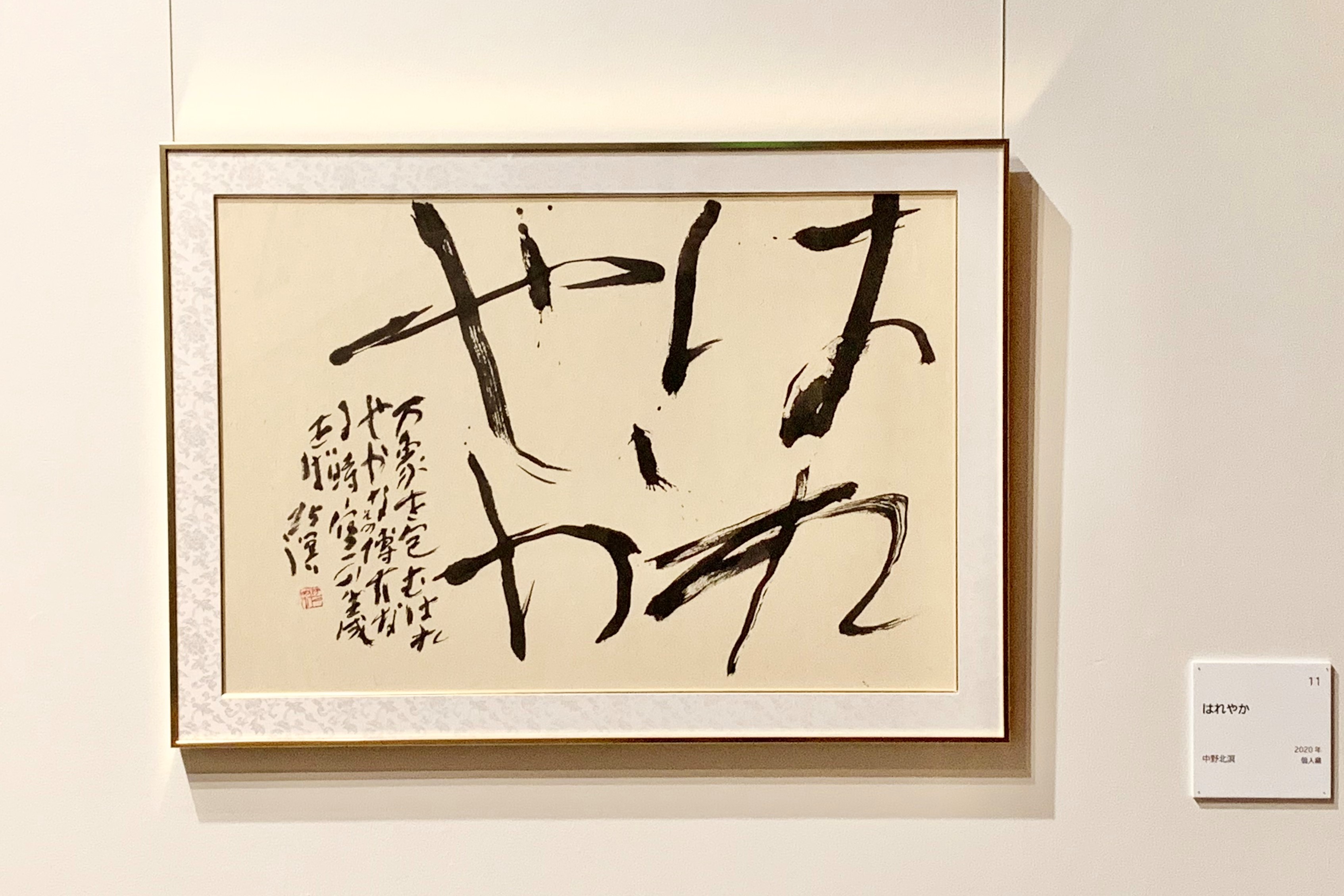
At the Tokyo Metropolitan Art Museum in Ueno, Tokyo , the Ueno Artist Project 2020 "Reading and Tasting Contemporary Books" is being held from Wednesday, November 18, 2020 to Thursday, January 7, 2021.
In this article,"Anyone reading the work of the" book ", exhibition so people can watch while enjoying" exhibition of exhibition content and attractions based on the concept, and in co-host of the (※ ~ session change on December 28, 2008) " We will also introduce "Showa no Sho to read and taste".
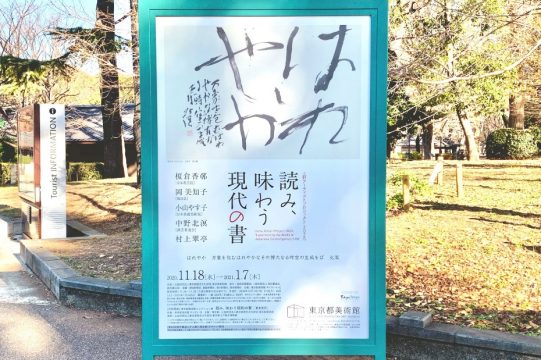
Poster signboard for this exhibition in Ueno Park
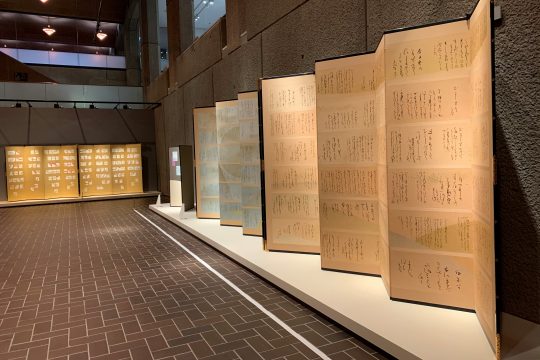
Exhibition scenery

Exhibition scenery
Even beginners can enjoy reading books! Enjoy the well-trained expressions of veteran writers
I think there are surprisingly many people who like art in general, but who find it difficult to read "calligraphy" and don't understand how interesting it is.
According to Mr. Tamura, a curator of the Tokyo Metropolitan Art Museum who introduced us to the exhibition, this "modern book to read and taste" can be enjoyed by people who feel "unfamiliar and unfamiliar" with such calligraphy. It was planned.
A collection of masterpieces from the "face of the modern calligraphers"! From masterpieces to new works in 2020

Nakano Hokumei << 1 >> 1961, private collection
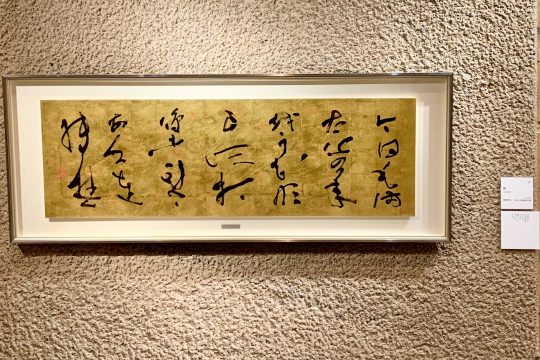
Koson Enokura << Travel >> 2012, Collection of Teikyo University Calligraphy Research Institute
This exhibition is the 4th installment of the "Ueno Artist Project", an initiative to introduce artists belonging to publicly recruited organizations by theme and disseminate their appeal. A veteran writer representing the modern calligraphers who has presented works of "modern poetry documents (books mixed with kanji and kana)" and "kana" at the open calligraphy exhibition.
・ Enokura Koson
・ Michiko Oka
・ Yasuko Koyama
・ Mr. Hokumei Nakano
・ Mr. Suitei Murakami
More than 30 works are on display, including the masterpieces of the above five people and the new works of this year.
As the reason for selecting the artist, Mr. Tamura said, "Many people are forced to have a hard time every day due to the influence of the new coronavirus. Even so, I would like people who come to the museum to see really good things . We have collected the works of super veteran teachers and realized the dream competition. "
Mr. Koyama passed away last year while Mr. Murakami was missed in 2018, but Mr. Enokura and Mr. Nakano are 97 years old this year, and Mr. Oka is 88 years old, but he is still active.
"Not only because the work has power, but also because we are working on new developments and continuing to do wonderful work on the front lines, we are encouraged and energized. I think you can get it, "continues Mr. Tamura.
This exhibition is lined with excellent books that are not intrusive, but are full of power that draws the viewer into the world of work. For those who want to know the fun of writing, it may be the best introduction.
It is safe for those who do not have knowledge of writing with a commentary

(Left) Koson Enokura << Hundred Tongue Birds and Frogs >> 2004, Collection of Calligraphy Research Institute, Teikyo University / (Right) Corresponding commentary
As a support tool for those who are not accustomed to viewing books, "Shakumon" will be distributed to all visitors.
The cursive script is an easy-to-read transcription of cursive and variant characters. By comparing the text with the work, the typeface that could only be recognized as a undulating line can be identified as a character to some extent! The author also helped me a lot. Please take a look around the venue with a commentary.
Introducing the exhibited works of "Modern Books to Read and Taste"
Let's take a look at the contents of the "Modern Book to Read and Taste" exhibition. We will pick up and introduce notable works in the flow of the route.
◆ Nakano Hokumei (1923 ~)
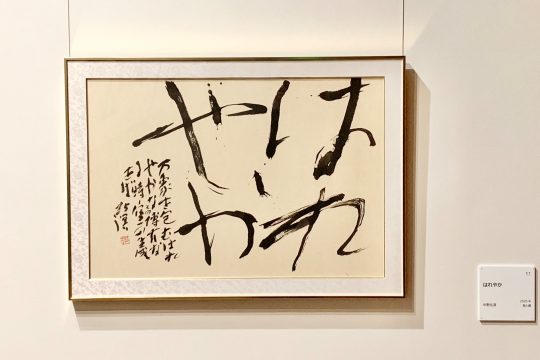
Nakano Hokumei "Hareyaka" 2020, private collection / adopted as a poster visual for this exhibition.
Mr. Nakano Hokumei, who has been creative in Hokkaido for many years, has established his own style of writing in the field of modern poetry. Mr. Nakano's book is very attractive because the characters are written freely with free brush strokes after rigorous training of writing style.
"Hareyaka" produced this year is also full of freshness and laid back. Please try tracing the handwriting once in the air. You may feel the comfort of flying in the sky in the wind.
It can be taken as a word of encouragement to the people who live in the Corona era, and it makes me feel at ease.
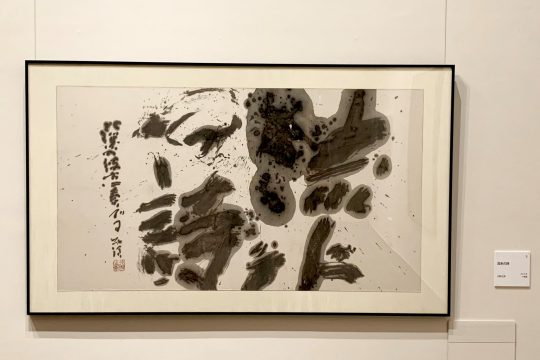
Nakano Hokumei << Poetry of drift ice >> 2015, writer's collection / More than half of the letters "ice" in the lower right are boldly out of the frame.
Mr. Nakano often deals with magnificent motifs such as "universe" and "sea". He is also good at dynamic works suitable for motifs, such as this "Drift Ice Poetry".
The overwhelming presence and intimidation of drift ice in the middle of winter that does not fit in the frame surrounded by people. Does the wide bleeding of light ink represent the appearance of melting ice? The beauty of the moment trapped in the ruggedness shines from the droplets that radiate out as if the ice had crushed in front of you.
◆ Suitei Murakami (1928 ~ 2018)
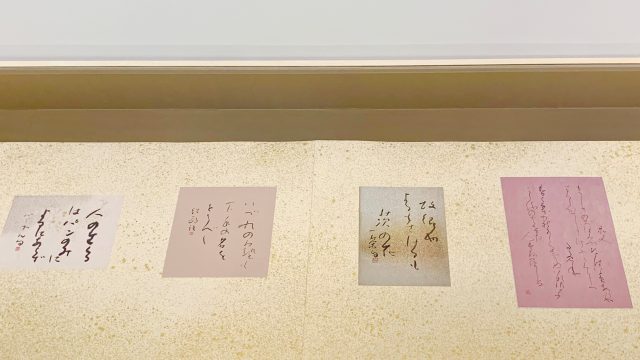
Suitei Murakami "Suitei Manic Book" (part) 2000, Daito Bunka University Collection
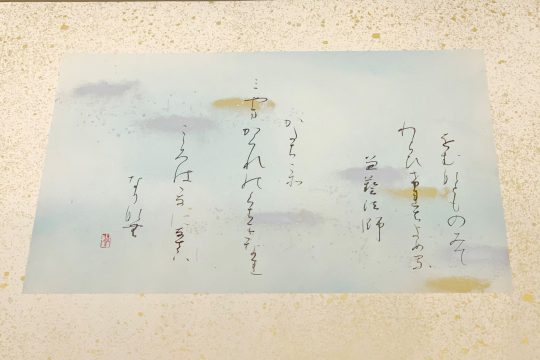
Suitei Murakami << Midoritei Manic Book >> (part) 2000, Daito Bunka University Collection / Paper (paper for writing books) Mr. Murakami, who was also a researcher of decoration. The special shaving pattern and the color of gold and silver sand are elegant.
Speaking of the fun of Suitei Murakami's calligraphy, it can be said that it has a variety of calligraphy styles.
The photo above is a part of "Suitei Manic Book" with 75 books pasted on the front and back of a 16m long tatami mat.
Poems and phrases from all ages and countries are selected as the subject matter, from "Takashikusa", Basho Matsuo, Issa Kobayashi to the Bible, but there are also modern and free writing styles like the old writings of the Heian period. There is also a wind … I'm amazed at the number of expressions that I can't imagine writing by myself.
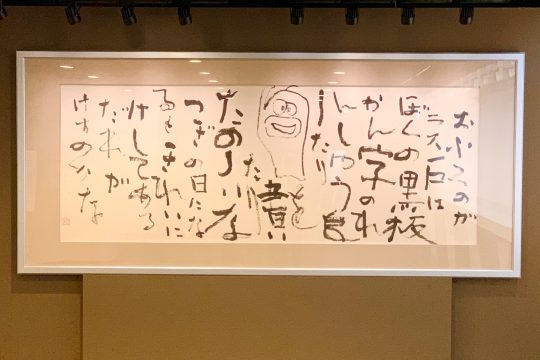
Suitei Murakami "Glass Door" 1967, Daito Bunka University Collection
"Glass Door" is a work based on a child's poem about scribbling on glass with a finger. Characters that look like Obake no Q-Turn are drawn, and "" is a mirror writing. It is one of Murakami's masterpieces with a lot of smiles, including the production as if it was really written by a child.
◆ Michiko Oka (1932 ~)
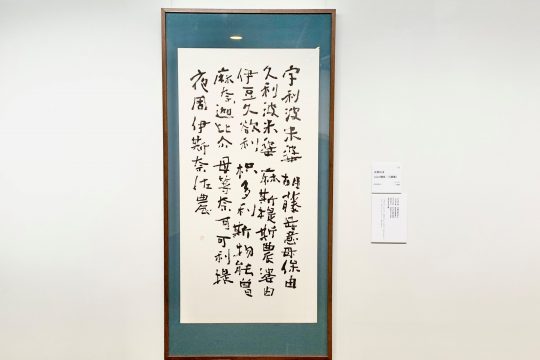
Michiko Oka 《Gourd Eating Meba (Yamanoue no Okura / Manyoshu)》 2020 ・ The writer's collection / It is a famous long song that sings a deep love for children, but you can enjoy it in a good way with the simple Man'yogana.
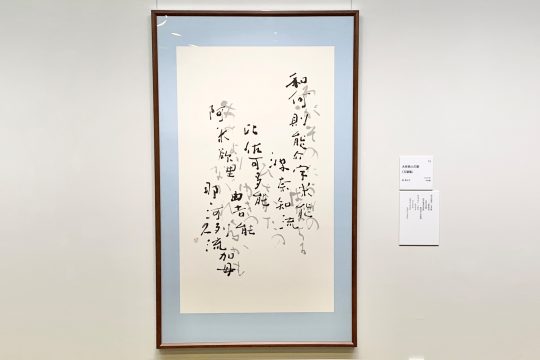
Michiko Oka << Otomo Traveler's Song (Manyoshu) >> 2020, Writer's Collection
One of the unique books by Ms. Michiko Oka, who creates works with Man'yogana, is a work that recognizes the hiragana corresponding to Man'yogana in the same book, which was written for this exhibition.
For example, "Otomo Traveler's Song (Manyoshu)" is overwritten with "Wakanori Noh …" written in dark ink and Man'yogana, and "Myself …" in light ink and hiragana. I am.
If you make a mistake, the screen may get messed up, but it's strange because the exquisite balance of opening and narrowing the space gives the work a neat impression.
Is it changing from dark ink to light ink to show the transition of time when Man'yogana is born into Hiragana? Is it a production that Hiragana is the shadow of Kanji? Imagination is agitated in various ways.
◆ Yasuko Koyama (1924-2019)
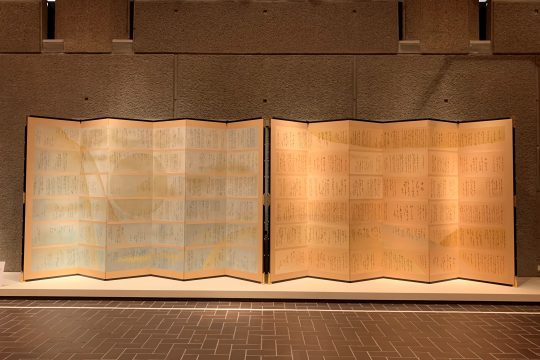
Yasuko Koyama "Ise Monogatari Folding Screen" 2002, Naritasan Museum of Calligraphy
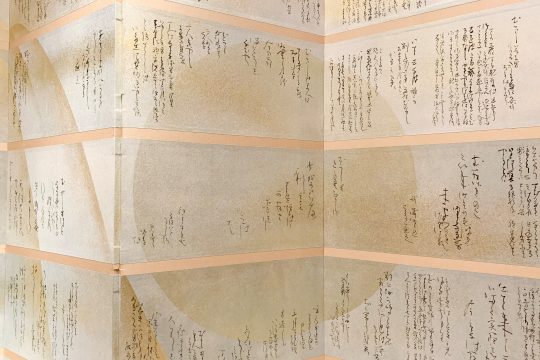
Yasuko Koyama "Ise Monogatari Folding Screen" (part) 2002, Naritasan Museum of Calligraphy
The work exhibited by Yasuko Koyama, who was selected as the first female person of cultural merit in the field of calligraphy, is just a masterpiece.
"Ise Monogatari Folding Screen" tailored with six songs and one pair is Mr. Koyama's masterpiece. The rough sketches, which are made by sprinkling foil and sand on the highest quality paper specially made with plenty of plum trunks and indigo, are tailored so that the scenery emerges when viewed from a distance.
Mr. Koyama's book is attractive for its gorgeousness that adds a modern sensibility to the beauty of the traditional Kana expression of the Heian period, but while making the best use of the goodness of the paper, arrange it so that you can read your own book in the best condition. The idea of how to do it is also a highlight. In particular, the strange arrangement of the books woven on the huge moon drawn on the left ship is surprisingly elegant.
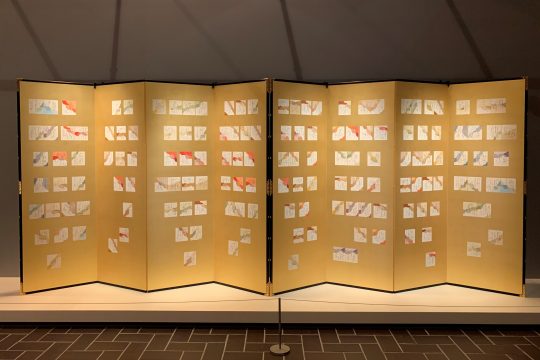
Yasuko Koyama "Thirty-six House Collection Folding Screen" 2003, Naritasan Calligraphy Museum Collection
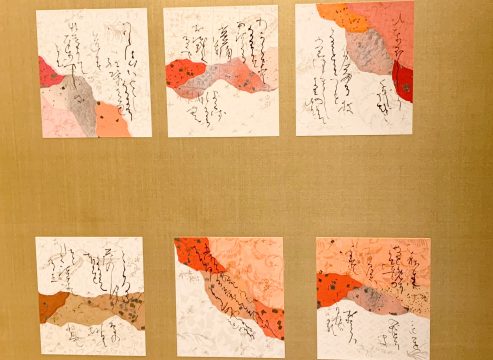
Yasuko Koyama "Thirty-six House Collection Folding Screen" (part) 2003, Naritasan Calligraphy Museum Collection
"Thirty-six House Collection Folding Screen" uses colorful joint paper (a sheet of paper with different colors and textures stuck together).
The flowing and elegant kana books that are pasted together are luxuriously used because each one is perfect enough to be appreciated. The colorful pattern on the paper is eye-catching, but please pay attention to the idea of changing it by writing letters only on the colored parts or conversely writing only on the white parts.
The double structure that the kana is scattered in the paper scattered in the folding screen is also a point. The various reverberations that unfold in the wind create a wonderful harmony as one work, creating a unique beauty.
◆ Koson Enokura (1923 ~)

Koson Enokura 《Flame》 2015 ・ Collection of Calligraphy Research Institute, Teikyo University / Vermilion reminiscent of flames with bright black thin lines rising like a heat haze.
In Koson Enokura's book, there are many omitted brush strokes and glyphs that have been deformed to the very limit of forming characters as characters.
This is remarkable in "Flame", which is based on the tanka of Bokusui Wakayama. While there are characters that are sharply squeezed horizontally, those that are stretched vertically and those that are simplified to the limit are drawn to the richness of the line's expression. It is also interesting that the brush stroke is thin and sharp like a needle or a knife.
It seems that the slowness and speed created by abstraction may give the work a protracted impression. This work has not changed until the last word "now" (rather, "now" is the most), and I am also attracted to the fact that it is tense and vivid.
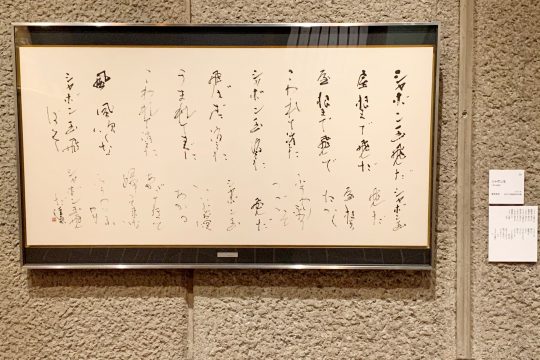
Koson Enokura "Soap Bubbles" 2010, Collection of Teikyo University Calligraphy Research Institute / The theme is the nursery rhyme "Soap Bubbles". The lower row is spelled with the ink withered, and overlaps with the ephemeral disappearance of soap bubbles over time.
An interlocking project, the Tokyo Metropolitan Art Museum collection exhibition "Reading and Tasting Showa no Sho" is also being held (* This exhibition only-the session will change to December 28)
Finally, we will introduce some of the exhibited works of "Reading and Tasting Showa no Sho" where you can appreciate the books of representative writers of the Showa era such as Yasuji Morita, Kanare Aoki, and Taiku Tokuno, including Kaneko Otei who advocated modern poetry documents. I will.
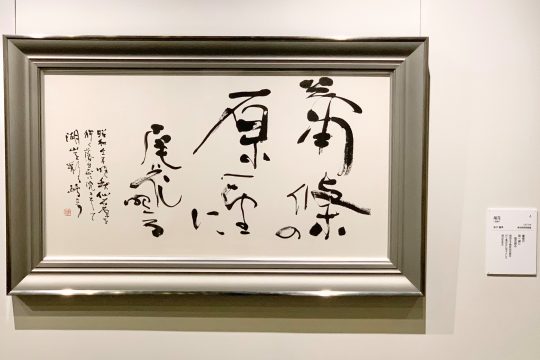
Kaneko Otei "Obana" 1973, Tokyo Metropolitan Art Museum Collection / The cleanliness of the brush strokes and the beauty of the margins in contrast to the elegant calligraphy are dazzling.
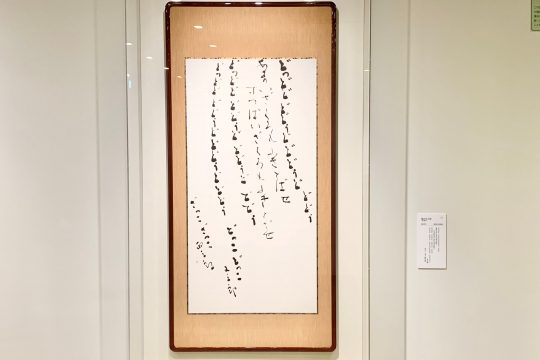
Yasuji Morita "Kaze no Matasaburo" 1949, Shizuoka Prefectural Museum of Art / A large amount of "do" as if it were blown by the wind. A masterpiece that created a sensation in the calligraphers' world at the time, with free writing that was not bound by common sense.
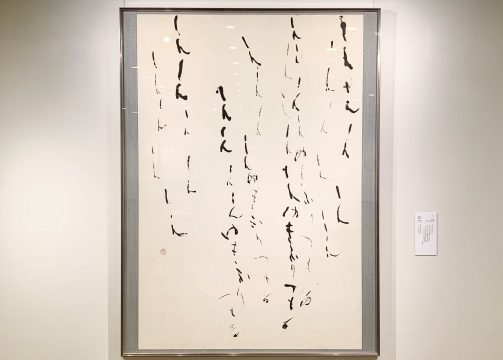
Kanare Aoki "Yuki" 1972, owned by Shotosha / Yasuji Morita A work that includes pictorial elements that can be felt. The sight and silence of the snowfall that I experienced in Tohoku are trapped as they are.
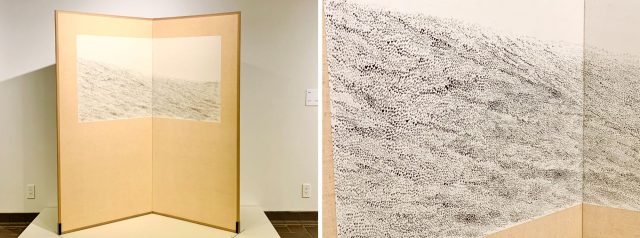
(Left) Taiku Tokuno << Meadow >> 1963, Naritasan Calligraphy Museum Collection / (Right) Same as on the left (Part) / A surprising piece, "Is this a book?" Like pointillism, only the variant "艸" of "grass" is written, and the grassland swaying in the wind and the gentle ridgeline are beautifully drawn.
The "Modern Book to Read and Taste" will be held until January 7, 2021 and there are only a few left.
Not to mention those who like books from the beginning, but also those who want to know the fun of books and beginners of books who want to touch really good works, please do not miss this opportunity.
Ueno Artist Project 2020 "Modern Books to Read and Taste"
| Session | November 18, 2020 (Wednesday) -January 7, 2021 (Thursday) |
| Venue | Tokyo Metropolitan Art Museum Gallery A / C |
| Closed days | December 7th (Monday), 21st (Monday), 29th (Tuesday) -January 3rd (Sunday) 2021 |
| Opening hours | 9: 30-17: 30 (Enter until 30 minutes before closing) |
| Admission fee | General 500 yen / 65 years old and over 300 yen * Free for students and younger * Free for persons with a physical disability certificate, love certificate, nursing certificate, mental disability certificate, health certificate for the atomic bomb survivors, and their attendants (up to 1 person). |
| Official site | https://www.tobikan.jp/exhibition/2020_uenoartistproject.html |
| Organizer | Tokyo Metropolitan Foundation for History and Culture Tokyo Metropolitan Art Museum |
| Cooperation | Sankei International Shodo Association, Mainichi Shodo Association, Yomiuri Shodo Association |
| Sponsorship | Asahi Shimbun, Sankei Shimbun, Mainichi Shimbun, Yomiuri Shimbun |


